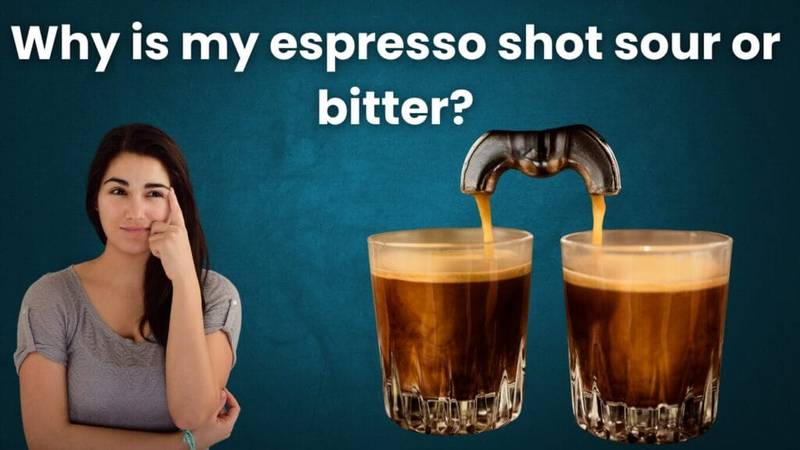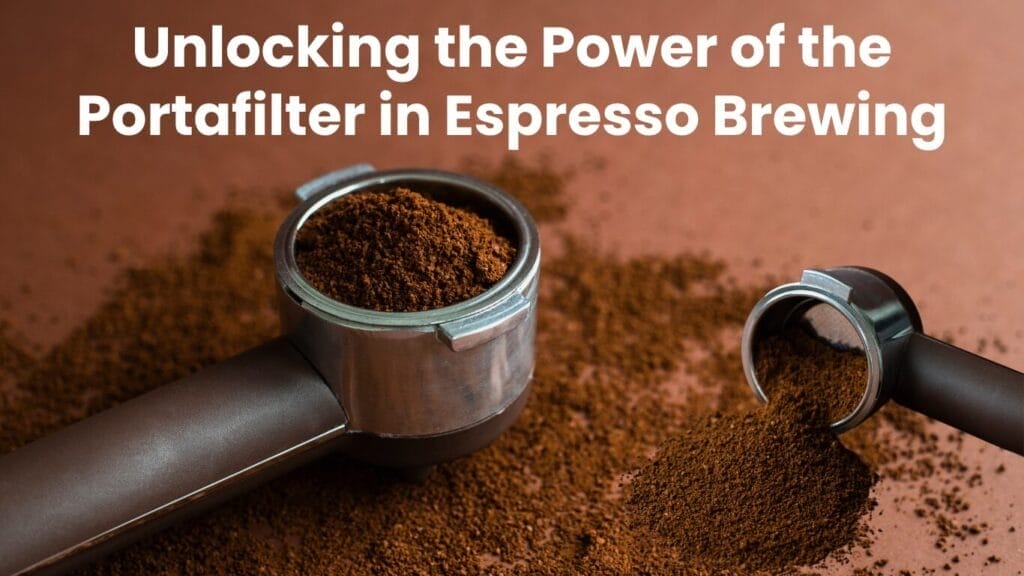It can seem like a combination of art and science to pull off a great espresso shot. Before adjusting your process, it might help to read some of our espresso machine reviews to understand how different models perform under pressure.
Just in case you were curious, “Why is my espresso shot sour or bitter?”, you’re not alone—and you’re not stuck. The fix often comes down to understanding a few key brewing factors. Let’s break them down.
Table of Contents
Why Is My Espresso Shot Sour or Bitter? Learn What You’re Doing Wrong

If your espresso bitter shot tastes sour like lemon or bitter like burnt toast, you’re not alone, and you’re probably making one of a few common mistakes.
Sourness often means under-extraction, caused by grinding too coarse, brewing too short, or using water that’s not hot enough. Bitterness, on the other hand, points to over-extraction, usually from too fine a grind, too much pressure, or brewing for too long.
Another culprit? Stale beans or improper tamping that disrupts water flow. Even the wrong water temperature—below 195°F or above 205°F—can ruin flavor balance.
To fix it, start with fresh beans, a consistent grind size, and ensure your extraction time falls between 25–30 seconds. Keep your machine clean, dial in your grind, and test your water temp. Taste improves dramatically when every element is tuned just right.
Sour Espresso: Common Causes and Fixes
A sour-tasting espresso typically points to under-extraction, meaning the coffee didn’t brew long enough to develop the full depth of flavor. Instead of a rich, balanced shot, you get one that’s overly sharp, acidic, or vinegary.
1. Grind Size is Too Coarse
When your grind is too coarse, water flows too fast through the puck, resulting in a quick, shallow extraction that doesn’t pull out the sugars and oils needed for balance.
Fix:
Use a finer grind setting. Water has more time to fully extract the flavor profile from the grounds as a result of the increased surface area and resistance.
2. The Water Temperature is Too Low
Water that’s cooler than 195°F (90°C) can’t dissolve and extract the flavorful compounds properly, leaving behind bright, sour notes. Always check that your espresso brew temperature is within the 195–205°F range to ensure optimal flavor extraction.
Fix:
Make sure your espresso machine reaches and maintains a consistent brewing temperature. If your machine doesn’t let you control the temperature, allow it to preheat fully before brewing. If your machine can’t heat properly, it may be an espresso machine heating problem that requires technical attention.
3. Shot Time is Too Short
If your espresso shot pulls in less than 20 seconds, it likely hasn’t brewed long enough to balance acidity with sweetness and body.
Fix:
Adjust your grind to a finer setting or tamp more firmly to slow down the flow. A double shot should have an extraction time of 25 to 30 seconds.
4. Dose Is Too Low
A lower-than-recommended coffee dose may lead to rapid water flow and a thin body, contributing to sourness.
Fix:
Measure your dose accurately using a digital scale, typically 18 to 20 grams for a double shot. This ensures proper resistance and flavor extraction.
5. Coffee Beans Are Too Fresh or Light Roast
Surprisingly, coffee that’s too fresh (less than 5 days post-roast) or very light-roasted beans can often taste sour, especially if under-extracted.
Fix:
Let your beans rest (degass) for at least 5–7 days after roasting. Also, note that lighter roasts may require a slightly finer grind and longer extraction time. Only use finely ground coffee grounds, espresso style—not drip or coarse grounds—to ensure proper extraction and resistance.
Why Is My Espresso Shot Sour or Bitter? Pressure Problems Explained
If you’ve fine-tuned your grind, dialed in your temperature, and still find yourself asking, “Why is my espresso shot sour or bitter? Now, let’s take a closer look at one of the most overlooked factors: brew pressure.
Espresso extraction depends heavily on pressure. Your espresso machine applies pressure—usually about 9 bars (130 PSI)—to force hot water through tightly packed, finely ground coffee. Many consumers are misled by labels like 15-bar espresso machine, when real extraction happens at 9 bar, and anything above that is rarely utilized during actual brewing.
When this pressure isn’t consistent or optimal, your espresso shot can swing wildly in flavor, becoming sour due to under-extraction or bitter due to over-extraction.
Let’s break down the most common pressure-related issues and how they contribute to poor espresso flavor.
Low Pressure = Sour Espresso
Low brew pressure is one of the primary causes of sour espresso shots. If the water isn’t forced through the coffee with enough pressure, it passes through too quickly, barely extracting the flavor-rich oils and sugars. The result? A thin, watery, under-extracted shot with a sour or lemony taste. Maintaining consistent espresso brewing pressure around 9 bars prevents under-extraction and helps achieve a balanced, flavorful shot.
Causes of Low Pressure:
- Weak or failing pump: Older or lower-end machines may lose pressure over time.
- Clogged group head or portafilter: Obstructions reduce the effectiveness of the pressure.
- Improper grind or dose: Too coarse a grind or too little coffee offers little resistance, letting water rush through.
Fix:
- Ensure your pump is functioning properly (listen for changes in sound or check the pressure gauge).
- Use a finer grind, slightly increase your dose, and make sure your puck offers adequate resistance.
- Clean your machine’s internal components to remove buildup that might reduce pressure delivery.
High Pressure = Bitter Espresso
Low pressure results in sour flavors, whereas too much pressure produces bitter, over-extracted espresso. If the water struggles to pass through the coffee puck—because of a too-fine grind, over-tamping, or too much coffee—your machine will build excessive pressure. That prolonged contact time pulls out unpleasant, harsh compounds from the coffee.
Causes of High Pressure:
- Grind is too fine: Overly fine coffee particles slow down water flow and create backpressure.
- Overdosing the basket: Too much coffee compresses tightly and restricts flow.
- Tamping too hard or unevenly: Excessive or angled tamping creates resistance and leads to uneven extraction.
Fix:
- Coarsen your grind slightly.
- Reduce the coffee dose to within your basket’s recommended range (usually 18–20g for a double shot).
- Tap with consistent, even pressure (around 30 pounds) and consider using a distribution tool.
Pressure Spikes and Channeling: A Mix of Sour and Bitter

Some of the worst-tasting espresso sour shots come from uneven pressure that causes channeling. Water then bypasses the rest of the coffee, flowing through cracks or weak spots in the puck where resistance is lowest. You’ll often get a shot that’s both sour and bitter, depending on where and how the water flowed through the puck.
An unevenly filled espresso machine portafilter often causes channeling, as it creates low-resistance paths for water to escape. Leaks are often signs of inconsistent pressure or gasket failure—especially in an espresso machine leaking under high load—which can further contribute to uneven extraction.
How to Detect Channeling:
- Watch your shot: Is it spraying unevenly or running out fast on one side?
- Taste inconsistency: Sour start with bitter finish.
- Examine the puck: Holes or erosion on one side are signs of channeling.
Fix:
- Before tamping, disperse the ground evenly using a WDT tool (Weiss Distribution Technique).
- Use a puck leveler to flatten the bed evenly before applying pressure.
- Tap with a consistent technique—level, firm, and without twisting.
How to Check and Control Pressure on Your Machine
Not all espresso machines give you control over pressure, but here’s how to work with what you’ve got:
- Machines with Pressure Gauges:
Watch the gauge during extraction. 8–10 bars is optimal. If you’re too low or too high, adjust your grind, dose, and tamp accordingly. - Machines with Pressure Profiling:
These machines allow you to ramp up or taper down pressure during extraction. Use lower pressure early in the shot to reduce channeling and bitterness, then build up for full extraction. - Machines Without Pressure Control:
Be sure to grind, dose, and tamp consistently. While you can’t change pressure directly, you can affect it indirectly through puck resistance.
FAQs|| Why is my espresso shot sour or bitter
Why is my espresso shot sour or bitter even with fresh beans?
Fresh beans still need proper grind, dose, and extraction; freshness alone doesn’t guarantee balanced flavor.
Can the grind size make my espresso sour or bitter?
Yes—too coarse causes sourness (under-extraction); too fine causes bitterness (over-extraction).
Why is my espresso sour in the morning but bitter later in the day?
Machine temperature, humidity, or grind shifts can change the extraction balance throughout the day.
Does water temperature affect why my espresso shot is sour or bitter?
Absolutely—low temperature causes sourness; high temperature increases bitterness.
How can I fix a sour or bitter espresso shot at home?
Adjust grind, dose, temperature, and shot time; aim for 25–30 seconds with even extraction.
Final thought:
Understanding why your espresso shot is sour or bitter is key to mastering the art of espresso. It’s rarely one single factor—grind size, water temperature, pressure, and extraction time all play crucial roles.
With patience and careful adjustments, you can transform every shot into a perfectly balanced, flavorful experience. If you’re just getting started, don’t forget to explore our coffee tips and guides for even more help dialing in your brew.







